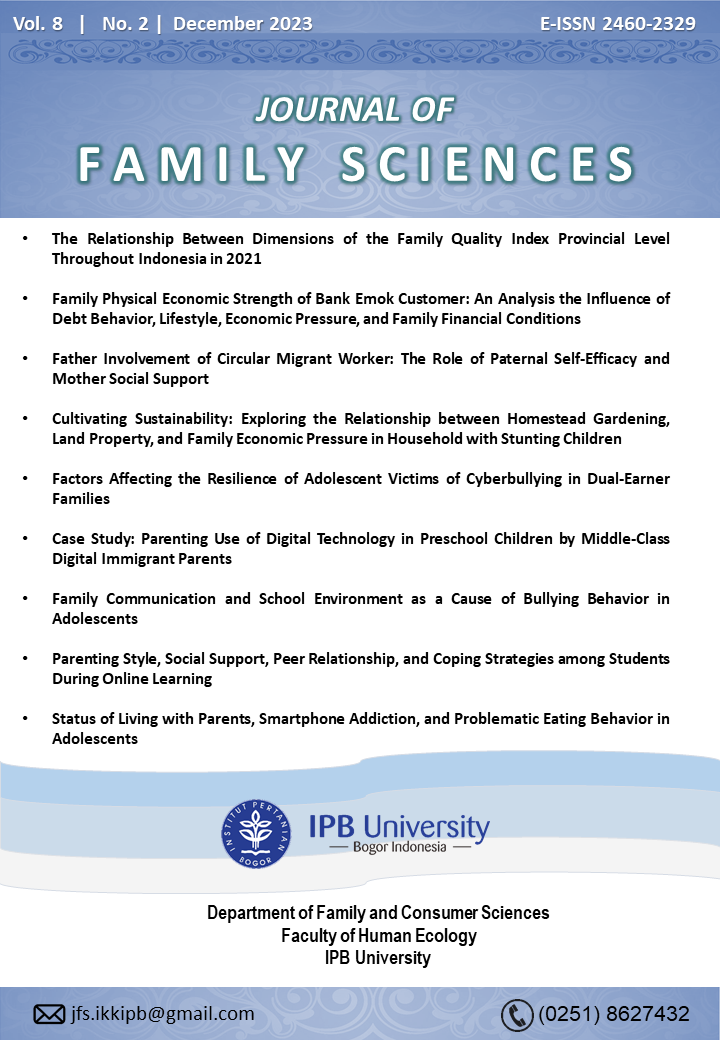Factors Affecting the Resilience of Adolescent Victims of Cyberbullying in Dual-Earner Families
Abstract
Adolescents are the age group that uses social media the most and is the age group most vulnerable to becoming perpetrators or victims of cyberbullying. This research generally aims to analyze differences based on region, relationship, and the influence of parent-adolescent interactions and coping strategies on adolescent resilience. This research uses a quantitative approach and cross-sectional study design using survey and questionnaire methods. Sampling was carried out using purposive sampling with a total sample of 98 adolescents. This research was located in Bogor Regency and City, West Java. The results of the independent t-test showed that there are significant differences in adolescent resilience based on region. The results of the correlation test show that adolescent age has a significant negative correlation with the dimensions of self-acceptance. Family size has a negative correlation with parent-adolescent interactions. Correlation test results show that parent-adolescent interaction and coping strategies significantly correlate with adolescent resilience. The results of regression tests show that region, mother's education, parent-adolescent interactions, and coping strategies significantly positively affect adolescent resilience. The parents-adolescent interaction, coping strategies, and resilience in adolescents in this study are mostly still in the moderate category, so they still need to be improved.
Downloads
References
Ager. (2013). Annual research review: Resilience and child well-being public policy implications. Journal of child psychology and psychiatry, 54, 488–500. https://doi.org/10.1111/jcpp.12030
Alavi, N., Reshetukha, T., Prost, E., Antoniak, K., Patel, C., Sajid, S., & Groll, D. (2017). Relationship between bullying and suicidal behavior in youth presenting to the emergency department. Journal of the Canadian Academy of Child and Adolescent Psychiatry, 26, 70-77. Retrieved from https://www.ncbi.nlm.nih.gov/pmc/articles/PMC5510935/pdf/ccap26_p0070.pdf
Andriani, F. (2018). Resiliensi korban cyberbullying dalam perspektif psikologi dan islam. Esoterik Jurnal Akhlak dan Tasawuf, 4(1), 78-100. http://dx.doi.org/10.21043/esoterik.v4i2.3462
Ansary, N. S. (2019). Cyberbullying: concept, theories, and correlates informing evidence-based best practices for prevention. Aggression and Violent Behavior. 50. https://doi.org/10.1016/j.avb.2019.101343.
Barlett, C. P. (2017). From theory to practice: Cyberbullying theory and its application to intervention. Computers in Human Behavior, 72, 269-275. http://dx.doi.org/10.1016/j.chb.2017.02.060.
Bottino, S. M. B., Bottino, C. M. C., Regina, C. G., Correia, A. V. L., & Ribeiro. (2015). Cyberbullying and adolescent mental health: systematic review. Cadernos de Saúde Pública, 31(3), 463–475. https://doi.org/10.1590/0102-311x00036114
Claudia, F., & Sudarji, S. (2018). Sumber-sumber resiliensi pada remaja korban perundungan di SMK Negeri X Jakarta. Jurnal Psibemetika, 11(2), 101-114. http://dx.doi.org/10.30813/psibernetika.v11i2.1436
Dwipa, I. M. D. K. S., & Chusairi, A. (2018). Gambaran resiliensi atlet bisbol Jawa Timur pasca cedera. Jurnal Psikologi Kepribadian dan Sosial, 7(1), 36–45. Retrieved from https://journal.unair.ac.id/download-fullpapers-jpks4eff25ebcafull.pdf
Fatimah, R., Sunarti, E., & Hastuti, D. (2020). Tekanan ekonomi, interaksi orang tua-remaja, dan perkembangan sosial emosi remaja. Jurnal Ilmu Keluarga dan Konsumen, 13(2), 137-150. http://dx.doi.org/10.24156/jikk.2020.13.2.137.
Firdaniaty, Lubis, D., Puspitawati, H., & Susanto, D. (2016). Komunikasi remaja dengan ayah masih minim: studi pada siswa di Kota Bogor. Jurnal Ilmu Keluarga dan Konsumen, 9(2), 124-135. https://doi.org/10.24156/jikk.2016.9.2.124
Hellsten, L. M. (2017). An Introduction to Cyberbullying Outline: Methodological Issues in Researching Cyberbullying. Retrieved from https://docenti.unimc.it/alessandra.fermani/teaching/2016/15583/files/slide-2-seminario-prof.ssa-hellsten
Hidajat, M., Adam, A.R., Danaparamita, M., & Suhendrik, S. (2015). Dampak media sosial dalam cyber bullying. ComTech: Computer, Mathematics and Engineering Applications, 6(1), 72. https://doi.org/10.21512/comtech.v6i1.2289.
Ikhwanus, A., Salamah, A., Khairana, A., Simanjuntak, M., Riany, Y. E. (2022). Case study of the mother-child interaction reality during online learning in the covid-19 pandemic. Journal of Family Sciences, 37-51. https://doi.org/10.29244/jfs.vi.39528.
Imani, F. A., Kusmawati, A., & Tohari, H. M. A. (2021). Pencegahan kasus cyberbullying bagi remaja pengguna sosial media. Journal of Social Work and Social Services, 2(1), 74–83.
Jannah, M. (2016). Remaja dan tugas-tugas perkembangannya dalam islam. Jurnal Psikoislamedia, 1(1), 244-256.
Lange, A., Evers, A., Jansen, H., & Dolan, C. (2002). PACHIQ-R: the parent-child interaction questionnaire-revised. Family Process, 41(4),709-22. https://doi.org/10.1111/j.1545-5300.2002.00709.x.
Larranaga, E., Yubero, S., Ovejero, A., & Navarro R. (2016). Loneliness, parent-child communication and cyberbullying victimization among Spanish youth. Computers in Human Behavior, 65, 1-8. https://doi.org/10.1016/j.chb.2016.08.015.
Maryam, S. (2017). Strategi coping: teori dan sumberdayanya. JURKAM: Jurnal Konseling Andi Matappa, 1(2), 101-107. Retrieved from https://media.neliti.com/media/publications/177181-ID-strategi-coping-teori-dan-sumberdayanya.pdf
Olsson, C.A., Bond, L., Burns, J. M., Vella-Brodrick, D. A., & Sawyer, S. M. (2003). Adolescent resilience: a concept analysis. Journal of Adolescent, 26, 1-11. https://doi.org/10.1016/s0140-1971(02)00118-5
Pratomo, Y. (16 Mei 2019). APJII: Jumlah pengguna internet di Indonesia tembus 171 juta jiwa. Internet. Retrieved from https://tekno.kompas.com/read/2019/05/16/03260037/apjii-jumlah-pengguna-internet-di-indonesia-tembus-171-juta-jiwa
Priyatna, A. (2010). Let’s end Bullying: Memahami, Mencegah dan Mengatasi Bullying. Jakarta (ID): PT. Elex Media Komputindo.
Putro, K. Z., Amri, M. A., Wulandari, N., & Kurniawan, D. (2020). Patterns of interaction between children and parents during the learning policy at home (pola interaksi anak dan orangtua selama kebijakan pembelajaran di rumah). Fitrah: Journal of Islamic Education, 1(1), 124–140. https://doi.org/10.53802/fitrah.v1i1.12.
Rachman, Y. A., Sunarti, E., & Herawati, T. (2020). Interaksi suami-istri, interaksi orang tua-anak, interaksi teman sebaya, dan resiliensi remaja. Jurnal Ilmu Keluarga dan Konsumen, 13(1), 1-12. http://dx.doi.org/10.24156/jikk.2020.13.1.1.
Rahmatika, N. S., & Handayani, M. M. (2012). Hubungan antara bentuk strategi coping dengan komitmen perkawinan pada pasangan dewasa madya dual karir. Jurnal Psikologi Pendidikan dan Perkembangan, 1(3), 1-8. Retrieved from https://journal.unair.ac.id/filerPDF/110911153_Ringkasan.pdf
Rahmawati, S. W. (2012). Hubungan antara coping strategy terhadap resiliensi siswa SMA dalam menghadapi ujian nasional. Jurnal Psiko Utama, 1(1), 43-57. Retrieved from https://www.researchgate.net/publication/324861451_HUBUNGAN_ANTARA_COPING_STRATEGY_TERHADAP_RESILENSI_SISWA_SMA_DALAM_MENGHADAPI_UJIAN_NASIONAL
Rasmin, M. Z., & Asni. (2022). Hubungan antara dukungan keluarga dengan resiliensi siswa pada saat pandemic. Jurnal Mahasiswa BK An-Nur: Berbeda, Bermakna, Mulia, 8(3), 57-63. http://dx.doi.org/10.31602/jmbkan.v8i3.7727
Rastati, R. (2016). Bentuk perundungan siber di media sosial dan pencegahannya bagi korban dan pelaku. Jurnal Sosioteknologi, 15(2), 169-186. https://doi.org/10.5614/sostek.itbj.2016.15.02.1
Rustham, T. P. (2019). Dual earner family dan pengaruhnya pada kesejahteraan psikologis anak: sebuah studi literatur. InSight, 21(1), 23-29. http://dx.doi.org/10.26486/psikologi.v21i1.757
Santrock, J. W. (2003). Adolescence (Perkembangan Remaja). In Kristiaji, W. C. & Sumiharti, Y (Eds). Jakarta (ID): Erlangga.
Sartana, & Afriyeni, N. (2017). Perundungan maya (cyber bullying) pada remaja awal. Jurnal Psikologi Insight, 1(1), 25-39. https://doi.org/10.17509/insight.v1i1.8442
Sari, D. P. C. (2017). Keterbukaan diri pada remaja korban cyberbullying. Psikoborneo, 5(1), 69-73. http://dx.doi.org/10.30872/psikoborneo.v5i1.4332
Sari, E. N. M. (2019). Hubungan antara emotion focused coping dan kepuasan hidup pada mahasiswa. Cognicia, 7(1), 95-111. https://doi.org/10.22219/cognicia.v7i1.8116
Sari, R. N., & Suryanto. (2016). Kecerdasan emosi, anonimitas dan cyberbullying (bully dunia maya). Persona: Jurnal Psikologi Indonesia, 5(1). https://doi.org/10.30996/persona.v5i01.741
Safaria, T. (2016). Prevalence and impact of cyberbullying in a sample of Indonesian junior high school students. The Turkish Online Journal of Educational Technology, 15, 1–3. Retrieved from https://files.eric.ed.gov/fulltext/EJ1086191.pdf
Sukmawati A, & Kumala, A. P. B. (2020). Dampak cyberbullying pada remaja di media sosial. ASJN: Alauddin Scientific Journal of Nursing, 1(1), 55-65. https://doi.org/10.24252/asjn.v1i1.17648
Sunarti, E., Islamia, I., & Rochimah, N., & Ulfa, M. (2018). Pengaruh faktor ekologi terhadap resiliensi remaja. Jurnal Ilmu Keluarga dan Konsumen, 10(2), 107–119. https://doi.org/10.24156/jikk.2017.10.2.107.
Syamsiah, R. I., Lestari, R., & Yuliatun, L. (2022). Hubungan gaya koping remaja dan keterlibatan orang tua dengan resiliensi pada remaja selama pandemi Covid-19. Jurnal Kesehatan Vokasional, 7(1), 32-41. https://doi.org/10.22146/jkesvo.67065
Tandiono, I. M., Dewi, F. I. R., & Soetikno, N. (2020). Ide bunuh diri pada remaja korban perundungan: keberfungsian keluarga dan kualitas hubungan pertemanan sebagai predictor. Jurnal Psikologi, 13(2), 156-172. http://dx.doi.org/10.35760/psi.2020.v13i2.3307
Utami, M. D., & Pratiwi, R. G. (2021). Remaja yang dilihat dari kelekatan orang tua terhadap kecerdasan emosi. Jurnal Ilmiah PSYCHE, 15(1), 35-44. https://doi.org/10.33557/jpsyche.v15i01.1379
Wardhani, R. H., Sunarti, E., & Muflikhati, I. (2019). Ancaman, faktor protektif, aktivitas, dan resiliensi remaja: analisis berdasarkan tipologi sosiodemografi. Jurnal Ilmu Keluarga dan Konsumen, 10(1), 47-58. http://dx.doi.org/10.24156/jikk.2017.10.1.47
Wagnild, G. M., & Young, H. (1993). Development and psychometric. J Nurs Meas, 1(2), 165–78. Retrieved from https://pubmed.ncbi.nlm.nih.gov/7850498/
Widianingsih, R, & Widyarini, N. M. (2009). Dukungan orang tua dan penyesuaian diri remaja mantan pengguna narkoba. Jurnal Psikologi, 3(1), 1-9.
Xu, J., & He, Y. (2012). Psychological health and coping strategy among survivors in the year following the 2008 Wenchuan earthquake. Psychiatry and Clinical Neurosciences, 66(3), 210–219. https://doi.org/10.1111/j.1440 1819.2012.02331.x
Authors who publish with this journal agree to the following terms:
- Authors retain copyright and grant the journal right of first publication with the work simultaneously licensed under

This work is licensed under a Creative Commons Attribution 4.0 International License. that allows others to share the work with an acknowledgement of the work's authorship and initial publication in this journal. - Authors are able to enter into separate, additional contractual arrangements for the non-exclusive distribution of the journal's published version of the work (e.g., post it to an institutional repository or publish it in a book), with an acknowledgement of its initial publication in this journal.
- Authors are permitted and encouraged to post their work online (e.g., in institutional repositories or on their website) prior to and during the submission process, as it can lead to productive exchanges, as well as earlier and greater citation of published work (See The Effect of Open Access).



_001.png)



